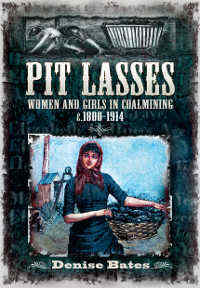Pit Lasses Research - Statistics
The Number of Female Miners in 1841
I examined the question of how many females were working underground in coal mines in 1842 whilst researching my book, Pit Lasses - Woman and Girls in Coalmining c1800-1914. The following is my current estimate of the position.
Official Census Figures 1841
| women 20+ years | women under 20 | Total | |
|---|---|---|---|
| England and Wales | 789 | 794 | 1,583 |
| Scotland | 396 | 371 | 767 |
| Total | 1,185 | 1,165 | 2,350 |
This figure of 2,350 was widely disseminated by Frederick Engels, and is the one which immediately comes to light for anyone trying to discover how many women and girls were employed in mining in 1842.
The Reports of the Children's Employment Commission, which collected its evidence is Spring 1841 reveal a different situation. It seems probable that 6 to 7,000 women and girls were working underground in coal mines at this point.
Children's Employment Commission Reports
These figures were provided by the colliery owners to the government investigators. Many owners ignored the request for information, resulting in understatement of the numbers. Those who gave figures did not necessarily provide accurate information. Where discrepancies occur they tend to under-report the number of females working at the pit.
| Adults | 13-18 years | under 13 years | Total | |
|---|---|---|---|---|
| Scotland | ||||
| Mid-Lothian | 341 | 189 | 54 | |
| Peebleshire | 17 | 7 | 13 | |
| East Lothian | 109 | 95 | 35 | |
| West Lothian | 65 | 52 | 37 | |
| Stirlingshire | 212 | 120 | 99 | |
| Perthshire | 157 | 165 | 68 | |
| Dunfermline – St Andrews | 305 | 181 | 57 | |
| Total | 1,206 | 809 | 363 | 2,378 |
| Lancashire | ||||
| (extracted from Pit Lasses Appendix A) | 365 | 315 | 114 | 794 |
| Yorkshire 1 | ||||
| (extracted from Pit Lasses Appendix B) | 86 | 139 | 164 | 389 |
| South Wales | ||||
| Pembrokeshire (Returns to Jones) | 132 | 37 | 6 | |
| Glamorganshire * | 45 | 43 | 27 | |
| Monmouthshire * | 1 | 4 | 1 | |
| Glamorganshire * | 5 | 2 | 1 | |
| Carmarthenshire * | 262 | 49 | - | |
| Pembrokeshire * (estimate) | 18 | 12 | 1 | |
| Total | 463 | 147 | 36 | 646 |
| (* personally visited by Franks) | ||||
| Grand total | 4,207 |
Additional Female Workers
Scotland
In East Scotland, sub-Commissioner Franks corrected the information provided by some collieries and felt that his totals were substantially accurate, but noted that some returns had not been received.
Sub-Commisisoner Tancred who investigated West Scotland discovered 82 females who are not included in the figures for Scotland.
In 1844 the newly-appointed Commissioner for Mines visited a few of the mines visited by Franks three years earlier. From his report it appears that the figures Franks obtained were understated by 128, raising the possibility of similar understatements elsewhere. Similarly, a mine visited by Tancred understated the number by 20.
I have now located the 767 Scottish women listed on the 1841 census as underground workers. Around 150 of them are in areas that were not visited by either Franks or Tancred and do not feature in either sub-Commissioner's report.
Lancashire
Many owners in Lancashire did not provide any returns. A large number of women were reported to work in Lancashire mines and many women subsequently found jobs at the pit head. It seems very likely that the Lancashire figure was substantially under-stated.
Yorkshire
Two reports were made for Yorkshire. Sub-Commissioner Symons included just the returns he received. It is not possible to identify what was missing. The second report contained no information about the gender of workers. Within the witness statements and tables, 24 girls can be identified. It seems likely that there were more female workers in Yorkshire than the two reports indicate.
Wales
The figures provided by Sub-Commissioner Franks relate only to the collieries he visited. Sub-Commissioner Jones, who had received the returns, reported that many owners refused to co-operate.
A number of the Welsh mines were co-located with iron works. Some females recorded at iron works may have been engaged in mining.
Other Areas
Small numbers of women and girls were noted in Cumberland and North Lancashire. Higher though unspecified numbers were referred to in Staffordshire and North Wales in surface occupations.
It is likely that some women worked when they were needed rather than every week. As returns were made at a point in time they were unlikely to include anyone not at work at that point.
Trying to adjust for the amount of the various understatements adds little value. The definitive data available, and knowledge of where understatement is likely to have occurred, suggests that 6 to 7,000 females were likely to be affected by the ban on underground work brought in by The Mines and Collieries Act 1842.


